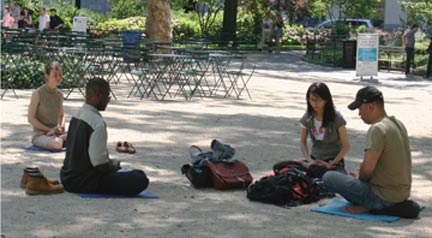New Year, New Habit:
Tips for a Successful Meditation Practice
Now that t he dust has settled after all the New Year’s celebrations, it’s a great time to think about trying something new on for size this year that will benefit both your mental and physical health, all year long. We’re talking about meditation, and I am going to share with you tips for a successful meditation practice. Meditation has been shown to keep you stress free, reduce the effects of aging, improve brain functioning, improve sleep, boost metabolism, and more.
he dust has settled after all the New Year’s celebrations, it’s a great time to think about trying something new on for size this year that will benefit both your mental and physical health, all year long. We’re talking about meditation, and I am going to share with you tips for a successful meditation practice. Meditation has been shown to keep you stress free, reduce the effects of aging, improve brain functioning, improve sleep, boost metabolism, and more.
So what’s the best way to start a new meditation routine?
Why is meditation important to you?
Determine ahead of time exactly what you expect to get from meditation, and why it is important to you personally. Knowing ahead of time why you meditate gives you something to draw on when you feel like skipping out on it. Write this down so if you start to fall off the meditation bandwagon so to speak, you have a good reminder of why you started in the first place.
Set up a designated meditation area.
An ideal space is one that is quiet, clean, uncluttered, has natural light, and has paint colors that are reflective of a calm mood. This place could be indoors or outdoors. Elements of nature can be a welcome addition to a meditation space as well. Think plants, seashells, or a small water fountain. Music can also really help in setting a zen-like mood. We typically recommend quiet music without lyrics to help you feel calm. Personal touches like aromatherapy, chimes, candles, and crystals can also help transition you into a meditative state. Remember to remove any distractions like the TV and your phone.
Time it for success.
Now that you have a relaxing and serene place to retreat to, it’s time to think of the days and times that will work best for you to meditate. It could be the weekends or early mornings before work. It really depends on your personal schedule. There is no right or wrong time to meditate.
Also consider how much time you have free for each session (for example, one day you may have 30 minutes free, another day you may only have 10 minutes you can set aside). Write this down somewhere that is easy to see (i.e. on the fridge) so you are reminded throughout the week of your designated meditation day(s) and time(s).
Start small and build up.
As with any new habit, tackle your new meditation practice a little bit at a time, and complete every practice. It will take discipline but you don’t need to be an expert at it right away. Practice for short periods of time to start with to ease into it. It is easier to allow yourself to step outside of your comfort zone even if you’re bored or restless if you it is only for a short time.
Pick something you will enjoy.
Choosing a meditation that you will actually enjoy (i.e. breathing meditations, visualizing with a pre-recorded meditation, moving mediation) will make you more likely you will stick with it today, tomorrow, and in the future. Here is a great article to give you a few more ideas of types of meditation you could choose.
Build some flexibility into your new routine.
Allow yourself to be fluid in some aspects of your practice, for example, if you feel like meditating longer than you normally do, then do. If you want to meditate in a different place or at a different time then you normally do, go right ahead! Allow yourself to play with it. While having a routine is valuable for building success into your practice, allowing yourself to experiment and play will keep it fresh. After all, it has been said that the spiritual path is mainly an inclination of the heart towards the mystery of life so don’t second guess it if you want to mix things up a bit!
All that’s left now is to PRACTICE, PRACTICE, and PRACTICE! If you need help getting started with your meditation practice let us know. We offer classes, guided meditations, and helpful articles like this one.
To your inner peace – Anna

 Asperger’s Syndrome is traditionally regarded as a developmental issue and is classed as a ‘high functioning’ autism spectrum disorder. Some people, however, argue that Aspergers is not so much a disorder, but is in fact a different way of thinking where the emphasis is more on being creative rather than co-operative. Regardless of the definition and reasoning, there are often common characteristics that people with Aspergers exhibit, and an awareness of these along with strategies for catering for them in a meditation class will help your Asperger’s client to get the maximum benefit from your classes.
Asperger’s Syndrome is traditionally regarded as a developmental issue and is classed as a ‘high functioning’ autism spectrum disorder. Some people, however, argue that Aspergers is not so much a disorder, but is in fact a different way of thinking where the emphasis is more on being creative rather than co-operative. Regardless of the definition and reasoning, there are often common characteristics that people with Aspergers exhibit, and an awareness of these along with strategies for catering for them in a meditation class will help your Asperger’s client to get the maximum benefit from your classes. The Washington Post recently ran an interesting article chronicling the study of one Sara Lazar, a neuroscientist at Massachusetts General Hospital and Harvard Medical School. Her study looked at the effects of meditation on the brain.
The Washington Post recently ran an interesting article chronicling the study of one Sara Lazar, a neuroscientist at Massachusetts General Hospital and Harvard Medical School. Her study looked at the effects of meditation on the brain. We’ve talked a lot about the relationship between meditation and pain and the valuable role that mindfulness plays in the equation. However, we have yet to delve into the research behind the relationship between mediation and pain management.
We’ve talked a lot about the relationship between meditation and pain and the valuable role that mindfulness plays in the equation. However, we have yet to delve into the research behind the relationship between mediation and pain management.
 Meditation is a HUGE topic and what I cover in this site is only a part of what meditation can encompass because I write for people who want simple, easy to learn mediations that they can incorporate into every day life. The following article gives you a glimpse into some well known types of meditation.
Meditation is a HUGE topic and what I cover in this site is only a part of what meditation can encompass because I write for people who want simple, easy to learn mediations that they can incorporate into every day life. The following article gives you a glimpse into some well known types of meditation.